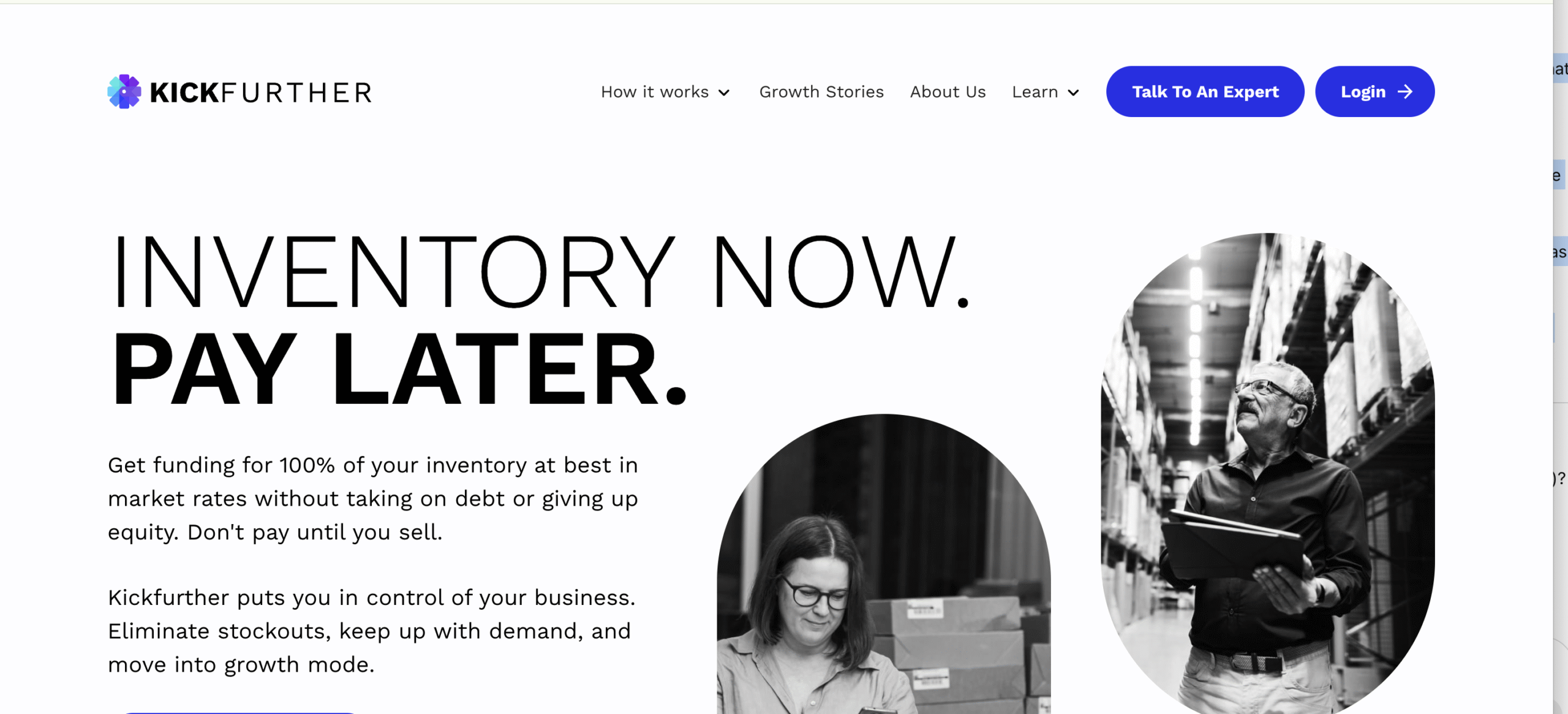Introduction
The world of online finance and crowd-based investing is full of platforms promising high returns and new ways to participate in business growth. One company that has caught the attention of both hopeful investors and frustrated customers is Kickfurther.com, a U.S.-based “inventory financing” marketplace.
At first glance, Kickfurther.com appears to offer a unique and innovative solution — connecting product brands that need inventory funding with investors willing to back them in exchange for profit. But a growing number of users claim that the platform is riddled with hidden risks, weak protections, and disappointing results. Many have gone as far as calling it a scam.
In this detailed review, we’ll break down how Kickfurther.com works, what investors and brands are saying, the red flags that make it a controversial name in alternative finance, and whether the accusations of it being a scam hold weight.
What Is Kickfurther.com?
Kickfurther.com promotes itself as an inventory financing platform designed for product brands, particularly those selling online or through retail channels. Instead of taking out traditional loans, a business can list an “opportunity” on Kickfurther, where individual investors contribute funds.
Here’s the basic concept:
-
Brands receive financing to produce inventory without taking on typical debt.
-
Investors fund these deals (called “Co-Ops”) and earn a profit as the brand sells its inventory.
-
Kickfurther.com facilitates the process, claiming to handle supplier payments and repayments as the brand completes sales.
On paper, the model sounds appealing. For brands, it means faster access to capital without going through a bank. For investors, it offers a way to earn higher returns than a savings account or a traditional bond. However, as many have discovered, the reality is far more complicated.
Why People Are Drawn to Kickfurther.com
For Brands
Kickfurther.com’s pitch to brands is straightforward: “Get the money you need to buy inventory without giving up equity or taking out a loan.”
Small and medium-sized businesses often struggle with cash flow — they need to buy inventory to grow, but they can’t secure affordable credit. Kickfurther.com promises to bridge that gap, offering fast funding and flexible repayment based on how quickly inventory sells.
This can be especially tempting for e-commerce businesses that experience seasonal spikes or rapid growth. The platform markets itself as a partner that grows with the brand.
For Investors
To the investor, Kickfurther.com offers something new — a chance to participate in real-world inventory deals with attractive return rates. Instead of earning 1–2% in a savings account, investors can supposedly earn much more by helping brands scale.
The idea of “backing physical products” feels tangible and exciting. Many are drawn in by the notion of supporting growing businesses while earning solid profits.
But, as is often the case in high-yield opportunities, the risks are significant — and in this case, poorly communicated.
The Growing Wave of Complaints
Over time, a pattern has emerged: while some brands speak positively about the funding they received, many investors report losing substantial amounts of money.
Common complaints include:
-
Lack of enforcement when brands default on payments.
-
Promised safeguards — like inventory collateral or personal guarantees — not being honored.
-
Limited transparency into a brand’s financial health or true risk.
-
Hidden platform fees and changing deal terms.
-
Minimal recovery or communication after defaults occur.
Numerous long-term investors have claimed to lose thousands of dollars after multiple brands they funded failed to pay back. Many accuse the platform of overselling the security of these deals and downplaying how often defaults occur.
The result is a growing perception that Kickfurther.com behaves more like a high-risk speculation scheme than a legitimate investment marketplace.
Key Red Flags and Structural Problems
After analyzing investor experiences and Kickfurther.com’s operating model, several major concerns stand out. These don’t necessarily mean the company is a deliberate scam — but they indicate that it carries characteristics often associated with deceptive or predatory platforms.
1. Misaligned Incentives
The fundamental issue with Kickfurther.com’s model is that brands and investors are not aligned.
-
Brands want quick cash to buy inventory and grow.
-
Investors want safety and steady returns.
When a brand struggles or fails to sell enough products, it may default on repayment. Kickfurther claims to provide protection through collateral and guarantees, but in practice, investors report that those protections are rarely enforced effectively.
The platform profits from fees regardless of whether the deal succeeds — a setup that favors deal volume over investor safety.
2. Weak or Non-existent Protections
Many investors were led to believe that their money was secured by the brand’s inventory or personal guarantees from company owners. But real-world experiences paint a different picture.
Once a deal goes bad, investors often find they have no real recourse. There’s limited evidence that Kickfurther pursues legal action or recovers assets. In most cases, investors simply lose their principal.
What’s worse, the documentation of each deal can be confusing or incomplete, making it difficult to prove what protection actually existed in the first place.
3. High Default Rates
Although Kickfurther.com doesn’t clearly publish its overall success or failure rate, investor accounts suggest that defaults are frequent and often total losses.
Some users have reported losing thousands of dollars across multiple failed Co-Ops. The lack of transparency around how many deals actually pay back fully versus how many collapse adds to the suspicion that the success rate is far lower than advertised.
A legitimate financial platform should provide audited performance data. Kickfurther does not.
4. Poor Transparency
Transparency — or the lack of it — is another recurring theme.
Investors often have limited information about a brand’s finances, existing debts, and true business stability. The listings provide marketing language and surface-level data, but not the kind of due diligence material an informed investor would need.
When defaults happen, updates can be vague, delayed, or non-existent. The company’s communication with investors has been described as robotic and unhelpful.
Without clear access to data, investors are essentially betting blind.
5. Shifting Terms and Hidden Fees
Several users have complained about “bait-and-switch” experiences. Brands report that they were pre-approved for a certain funding amount or rate, only to see that amount changed at the last minute. Others claim new platform fees appeared late in the process, reducing their proceeds unexpectedly.
On the investor side, fees and repayment terms are not always transparent either. The lack of clarity around how Kickfurther.com makes its money raises questions about whether the platform’s revenue comes more from upfront fees than from successful, long-term partnerships.
6. Lack of Regulation
Unlike traditional investment firms or regulated crowdfunding portals, Kickfurther.com does not operate under any major financial regulatory framework. This means:
-
Investors do not have the same protections that exist for securities or banking products.
-
There is no insurance or oversight ensuring fair practices.
-
Disputes are subject to private contracts rather than consumer protection law.
Essentially, participants are on their own — trusting a private company’s word that it will manage funds responsibly.
7. Too Good to Be True Marketing
A final red flag lies in how Kickfurther.com markets itself. The platform emphasizes the success stories — the brands that grew, the investors who earned returns — but provides no comprehensive or audited data about failure rates.
The absence of transparent statistics, combined with testimonials that sound overly polished, creates a marketing narrative that can easily mislead inexperienced investors.
If an investment promises double-digit returns while claiming to be “secured,” but fails to back that claim with hard data, caution is warranted.
Why Many Call It a Scam
While there’s no public proof that Kickfurther.com is committing outright fraud, several aspects of its business create a scam-like experience for users.
Here’s why many people use that word:
-
Investors lose money with no accountability. When a deal fails, Kickfurther.com often provides little explanation or follow-up.
-
Promised protections appear meaningless. The inventory and guarantees investors thought they had rarely result in repayment.
-
Transparency is minimal. Key information about risk, brand finances, and overall platform performance is withheld.
-
The company still profits even when investors lose. Kickfurther.com collects fees regardless of deal outcome.
-
Communication drops after defaults. Investors describe being left in the dark with little or no customer support.
These patterns mirror the behaviors of companies that operate in the gray zone between incompetence and deception.
The Psychology Behind the Platform
Kickfurther.com’s success depends on two emotional triggers: trust and greed.
Investors trust the idea that they are backing “real” inventory — something tangible. They believe the risk is lower than, say, crypto or penny stocks. At the same time, the promise of double-digit returns feeds greed — the desire for passive income without volatility.
Brands, on the other hand, are enticed by the promise of easy capital without paperwork or collateral. For struggling businesses, that can sound like salvation.
But when both sides operate on emotion rather than careful analysis, platforms like Kickfurther thrive — collecting fees while users take the real risk.
The Bigger Picture: Why Platforms Like Kickfurther Exist
Kickfurther.com’s existence highlights a broader trend in online finance: the rise of alternative investment platforms that operate outside traditional regulation.
These platforms fill a market gap — small businesses can’t always get loans, and small investors want access to “exciting” opportunities. But that same freedom from regulation also means less oversight, weaker accountability, and a higher risk of loss.
In essence, platforms like Kickfurther.com transfer the burden of risk from banks to individuals, often without making that trade-off fully clear.
Is Kickfurther.com a Scam or Just a Bad Bet?
Based on the evidence, Kickfurther doesn’t appear to be a deliberate fraud — but it functions in a way that exposes participants to extreme levels of risk with minimal protection.
The company likely operates legally, but that doesn’t mean it operates ethically. When investors lose large sums and have no recourse, it creates the same outcome as a scam, even if the mechanism is different.
In simple terms:
-
Kickfurther.comr is not a proven Ponzi scheme or fake business.
-
It is a high-risk, poorly structured platform that misleads users about the true safety of their money.
The smartest approach is to treat any investment on Kickfurther.com as speculative gambling, not finance. Only invest money you are prepared to lose entirely.
Lessons for Investors
-
If returns sound too good to be true, they are. High yields always come with hidden risks.
-
Demand transparency. Never invest in a platform that hides performance data or refuses to show audited results.
-
Avoid emotional investing. Platforms like Kickfurther use marketing that appeals to both greed and goodwill. Stick to numbers, not stories.
-
Know what you’re buying. “Inventory financing” sounds safe, but without clear collateral rights, it’s just an unsecured loan.
-
Regulation matters. Platforms outside established financial oversight are dangerous for casual investors.
Lessons for Brands
If you’re a business owner considering Kickfurther.com for financing, be cautious as well.
While some companies report positive experiences, others describe the process as confusing, inconsistent, and laden with unexpected costs. You may be better off seeking financing through traditional channels, even if it means slower approval or stricter requirements.
Final Verdict
After reviewing numerous accounts and analyzing the platform’s structure, it’s clear that Kickfurther.com occupies a murky middle ground between innovation and exploitation.
It may not be a deliberate scam in the criminal sense, but it’s undeniably a platform where the odds are stacked against investors. The protections are weak, defaults are frequent, and transparency is minimal.
Brands may find short-term relief in its financing options, but investors should treat it as a speculative gamble rather than a safe investment.
In the end, the smartest move is simple: stay away unless you fully understand — and can afford — the risks involved.
Report Kickfurther.com Scam and Recover Your Funds
If you have lost money to Kickfurther.com, it’s important to take action immediately. Report the scam to LOSTFUNDSRECOBERY.COM, a trusted platform that assists victims in recovering their stolen funds. The sooner you act, the better your chances of reclaiming your money and holding these fraudsters accountable.
Scam brokers like Kickfurther.com continue to target unsuspecting investors. Stay informed, avoid unregulated platforms, and report scams to protect yourself and others from financial fraud. Read More reviews at Scams2Avoid



